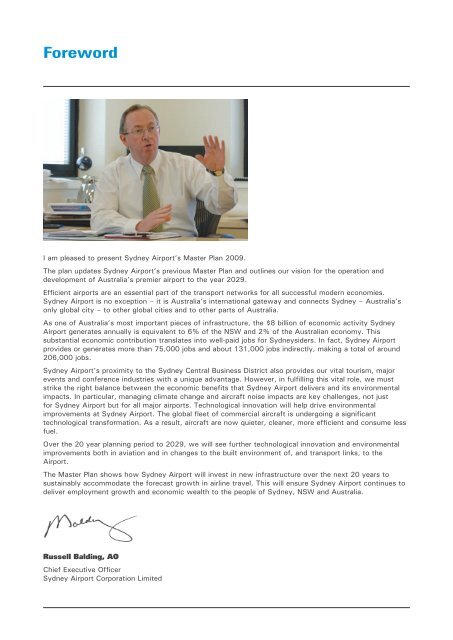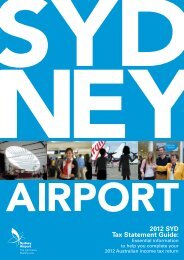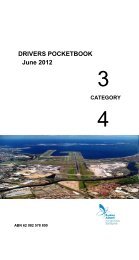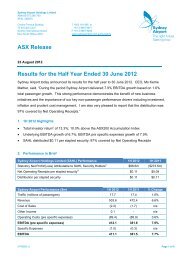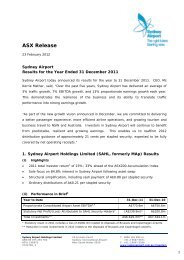Master Plan 2009 - Sydney Airport
Master Plan 2009 - Sydney Airport
Master Plan 2009 - Sydney Airport
You also want an ePaper? Increase the reach of your titles
YUMPU automatically turns print PDFs into web optimized ePapers that Google loves.
Foreword<br />
I am pleased to present <strong>Sydney</strong> <strong>Airport</strong>’s <strong>Master</strong> <strong>Plan</strong> <strong>2009</strong>.<br />
The plan updates <strong>Sydney</strong> <strong>Airport</strong>’s previous <strong>Master</strong> <strong>Plan</strong> and outlines our vision for the operation and<br />
development of Australia’s premier airport to the year 2029.<br />
Efficient airports are an essential part of the transport networks for all successful modern economies.<br />
<strong>Sydney</strong> <strong>Airport</strong> is no exception – it is Australia’s international gateway and connects <strong>Sydney</strong> – Australia’s<br />
only global city – to other global cities and to other parts of Australia.<br />
As one of Australia’s most important pieces of infrastructure, the $8 billion of economic activity <strong>Sydney</strong><br />
<strong>Airport</strong> generates annually is equivalent to 6% of the NSW and 2% of the Australian economy. This<br />
substantial economic contribution translates into well-paid jobs for <strong>Sydney</strong>siders. In fact, <strong>Sydney</strong> <strong>Airport</strong><br />
provides or generates more than 75,000 jobs and about 131,000 jobs indirectly, making a total of around<br />
206,000 jobs.<br />
<strong>Sydney</strong> <strong>Airport</strong>’s proximity to the <strong>Sydney</strong> Central Business District also provides our vital tourism, major<br />
events and conference industries with a unique advantage. However, in fulfilling this vital role, we must<br />
strike the right balance between the economic benefits that <strong>Sydney</strong> <strong>Airport</strong> delivers and its environmental<br />
impacts. In particular, managing climate change and aircraft noise impacts are key challenges, not just<br />
for <strong>Sydney</strong> <strong>Airport</strong> but for all major airports. Technological innovation will help drive environmental<br />
improvements at <strong>Sydney</strong> <strong>Airport</strong>. The global fleet of commercial aircraft is undergoing a significant<br />
technological transformation. As a result, aircraft are now quieter, cleaner, more efficient and consume less<br />
fuel.<br />
Over the 20 year planning period to 2029, we will see further technological innovation and environmental<br />
improvements both in aviation and in changes to the built environment of, and transport links, to the<br />
<strong>Airport</strong>.<br />
The <strong>Master</strong> <strong>Plan</strong> shows how <strong>Sydney</strong> <strong>Airport</strong> will invest in new infrastructure over the next 20 years to<br />
sustainably accommodate the forecast growth in airline travel. This will ensure <strong>Sydney</strong> <strong>Airport</strong> continues to<br />
deliver employment growth and economic wealth to the people of <strong>Sydney</strong>, NSW and Australia.<br />
Russell Balding, AO<br />
Chief Executive Officer<br />
<strong>Sydney</strong> <strong>Airport</strong> Corporation Limited


